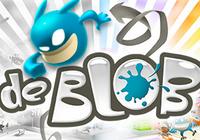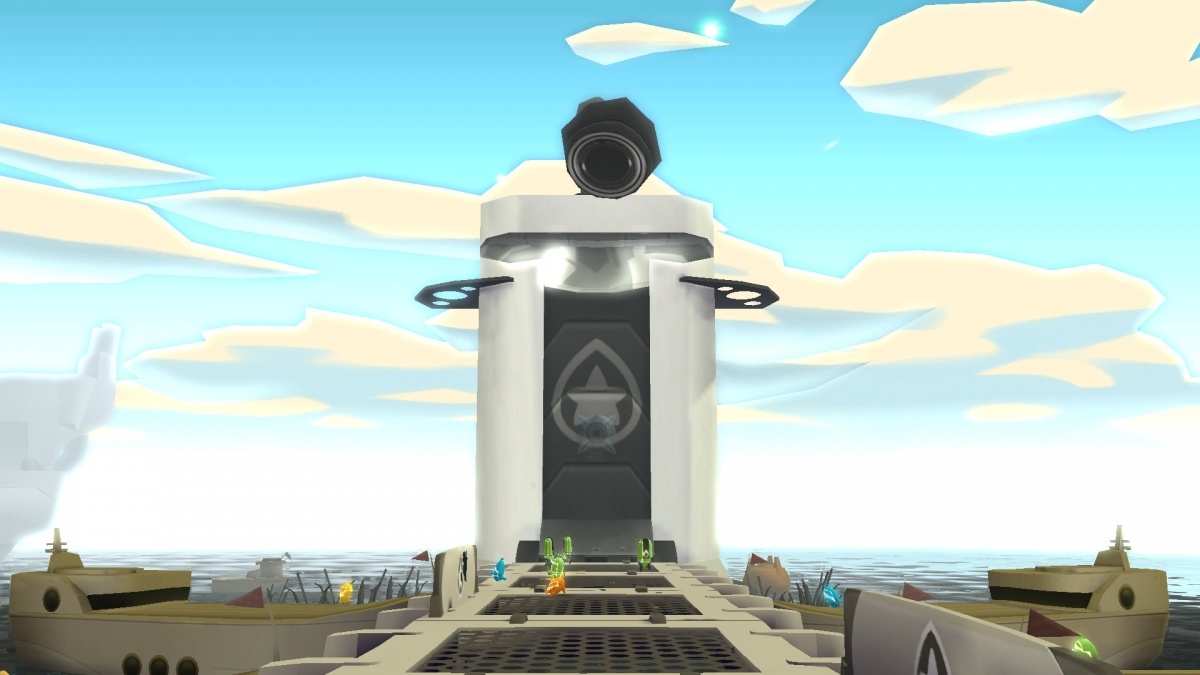de Blob (PlayStation 4) Review
By Coller Entragian  03.12.2017
03.12.2017

de Blob was a bit of a sleeper hit when it first came out on Wii. It has stylish visuals and a unique art style that helped it stand out and allowed it to compete with the more technically sophisticated PlayStation 3 and Xbox 360 games on the market. It was successful enough that THQ green-lit a sequel for the more powerful consoles at the time, which sadly did not get the same reach as its predecessor. With the original publisher now reborn as THQ Nordic, many of its last generation releases have been given remasters and ports on modern hardware. Titles like both Darksiders, Lock's Quest and now de Blob are getting the chance to remind people why they captured people's imaginations in the first place.
The Wii was an absurdly popular console that got tons of support and got developers to create unusual, high concept games. Ubisoft made a Rabbids game that was an adventure-action title, Capcom did a point-and-click puzzler with Zack & Wiki: Quest for Barbaros' Treasure, and Grasshopper Manufacturer delivered both No More Heroes titles. The Wii simply was king of cult-hits. Even Donkey Kong Country Returns was a smash hit, selling more copies than all three Metroid Prime games combined.

When de Blob came out, it fit right in with the wild assortment of games that were flying off the shelves due to the Wii's popularity. Even exceptionally low quality titles got thrown into the Wii's library and sold like gangbusters, like the Petz games series. It begs the question if de Blob was actually any good or if it was just lucky to sell so well because it was on the highest selling console of the times. With THQ Nordic digging into its catalogue and up-rezzing them neatly, de Blob on PlayStation 4 has to prove if it can make it on its own merits.
Thankfully, this generally holds up fairly well, for the most part. Granted, this is a very straightforward port of a Wii title with no frills or extra effects added. The art direction holds up very well and has a timeless cartoon quality about it that has endured almost ten years now. What has been neglected is the first thing most people will notice: the CGI pre-rendered cut-scenes are displayed in a woefully low resolution. It's pretty sad how little care was given to the FMVs because so much of the charm in the world was depicted in these short vignettes that are peppered throughout.

There is a lot of pixelated noise present in each short, which shouldn't be the case since the publisher should have the original animation files somewhere, which could have easily been set to 1080p, instead of a pitiful 480p. Outside of the cut-scenes, the core game looks passable and is untouched. THQ Nordic did not enhance anything other than the display and frame-rate, which is naturally higher and more stable.
The gameplay cycle of de Blob is as simple as it is enjoyable: manoeuvre a ball of slime in an open urban setting, gathering ink to paint the town while the timer ticks down. Fulfilling challenges along the way will increase the allotted time to spend in each stage to colourise it from Graydian control. Since each city is under a totalitarian control of black ink splotches, naturally the only way to fight back is to take control away from one fascistic form of control and give it to another. Such is life in a simplistic videogame aimed for children. Themes of revolutionaries aside, the plot is just here to service the action of taking control over real estate using colour.
It is a simple and mindless mechanic, but so satisfying thanks to the way de Blob uses audible feedback that sends all kinds of delightful pleasure neurons to the human brain. The way the soundtrack keeps adding layer upon layer with each splash of colour is so basic, yet effective, that it's a mystery why so many games don't even try to capitalise on this small, yet effective flourish. One thing to bear in mind, de Blob was originally a Wii game, and there are some aspects of it that did not translate well when getting converted onto the PS4.

The most obvious and apparent quality is the camera system that was not originally controlled with a second analogue stick. Trying to aim the camera in de Blob in here is a nightmare. The POV will frequently be flying all over the place, seemingly doing whatever, like a sugar-addled four-year-old on Christmas Day. All of this is made worse due to some extremely confusing jumping mechanics that never work as expected. Blob has a sluggish short hop and can slide along the sides of vertical surfaces, of which he can wall-jump from. The problem here is that because his jump is so low, he will frequently get caught on low ledges, and slowly drip down the side like an ice-cream cone that has been thrown against the wall. Trying to break out of this naturally makes players press the jump button, which will launch the snot-rocket in the opposite direction than intended. Other times, a more technical and skilled user may try to capitalise on this wall-jumping mechanic to cover a lot of ground or pull off some trick moves to reach new heights, only for it to not work when needed. The platforming is not de Blob's strongest suit, and is best when things are kept simple.
This was lucky to come out on the Wii when it was hot. It seems like it was only a hit because the Wii was a hit. It is still a legitimately well-made game, but it is easily out-done by its sequel. This is also a pretty lengthy title for how simple it is and can feel really exhausting after extensive play. Since each stage is timed, it would be easy to assume that play-time would be in short bursts but the reality is de Blob is extremely generous with how much time it gives. With every challenge completed and bonus clock collected, it seems like it can take about 40 minutes to an hour complete a single level. This was something THQ Nordic could have added to make this version more exciting: a hard mode. Using time-pressure in a game like this is a great idea, but is ultimately wasted with how much time is awarded, which makes the timer ultimately pointless. This was so pointless that the developer realised this and axed the timer entirely in the superior sequel.

Cubed3 Rating
Average
Anyone who was already a fan of de Blob will likely enjoy replaying it on the PS4. This is as straightforward as ports go, with no added features or graphical effects. Regretfully, the pre-rendered CGI cut-scenes have not been given the care they deserve, and the controls were not carefully considered when translating them to a DualShock 4. There should have been a bit more effort put into this instead of almost none. Some annoying control quirks aside, the core gameplay still manages to be addictive. The timeless style of the visuals and jazzy music gives this a charm that is rarely achieved. Hopefully, this will pave the way for the superior de Blob 2's PS4 conversion.

![]() 5/10
5/10
![]() 0
(0 Votes)
0
(0 Votes)
 Out now
Out now  Out now
Out now  None
None  Out now
Out now Comments
Comments are currently disabled

 Sign In
Sign In Game Details
Game Details Subscribe to this topic
Subscribe to this topic Features
Features





 Top
Top

